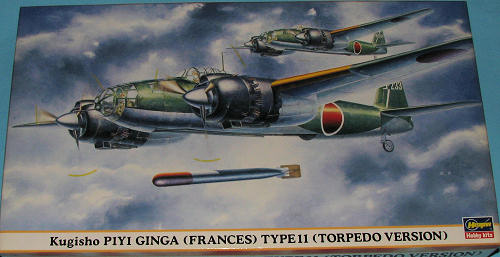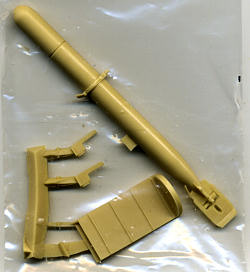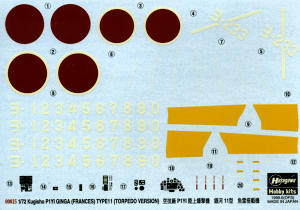
|
KIT # |
00025 |
|
PRICE: |
$10.00 on sale. SRP was around $45.00 |
|
DECALS: |
One Aircraft |
|
REVIEWER: |
|
|
NOTES: |
Includes resin torpedo. 1999 boxing |

|
HISTORY |
The Japanese never really had a fast, twin engined medium bomber until 1944 when the Army deployed its Ki-67 Hiryu and the Navy its P1Y1 Ginga (Milky Way). Until then, they had relied on updated prewar designs that were unsuitable for the kind of war they had gotten themselves into. The development of the Ginga was a rocky road to say the least. Design work started in 1940 with the aim of building a plane that was the equivalent of the Ju-88 or B-25. To do that, required a sleek airframe and powerful engines. Unfortunately, the Nakajima Homare engine was chosen. This engine showed a great deal of promise and so many aircraft builders wanted it for their new designs. When it worked well it was a superb powerplant, however that was the problem. It rarely worked as advertised.
When the prototype Gingas were made it was found that they had a lot of hydraulic systems that just didn't seem to want to work properly. Even in the best of times, maintenance was not easy and there were a number of problems with the hydraulics. Despite this, the plane was put into production, hoping that the difficulties could be cured while the planes were being built. It just didn't work out that way. Despite production P1Y1 aircraft coming off the production lines in late 1943, it wasn't until October of 1944, when over 450 airframes had been produced, that the Navy finally accepted the aircraft. Even then a large number were found unsuitable for service due to serviceability and reliability problems.
Despite these problems, the aircraft was found to meet the expectations of the Navy in terms of speed, range and bomb load. Eventually the engine situation with the Homare became tolerable, but it was feared that production of engines would be insufficient. To that end, Kawanishi decided to install Mitsubishi Kasei engines, which offered similar power as the Homares but were much more reliable. This was the P1Y2, many of which were developed as the P1Y2-S night fighter. As experience with the plane increased, serviceability improved and a number of interesting modifications and variants were suggested. However, the end of the war put a halt to all these plans.
|
THE KIT |
 This is another of the continuing line of Hasegawa twin-engined bombers. As
you can see from the sprue image, there are quite a few parts and pieces to it.
However since the Frances was not built in too many different variants, there
are not a lot of interchangeable subassemblies to cause construction
problems.
This is another of the continuing line of Hasegawa twin-engined bombers. As
you can see from the sprue image, there are quite a few parts and pieces to it.
However since the Frances was not built in too many different variants, there
are not a lot of interchangeable subassemblies to cause construction
problems.
Molded in Hasegawa's usual grey plastic, the level of detailing is all that we have come to expect from Japan's premier aircraft kit producer. There were a few parts that had rather thick mold seams and a few ejector pin markings will have to be filled, the most difficult of those being in the bomb bay, but overall, there are no mold problems with the parts themselves. I have read that when one cuts away the braces inside the engine cowlings to use a razor saw and work carefully. Apparently it is easy to split open the cowling! Typically, the cockpit is somewhat basic and relies on decals for instruments.
 The P1Y1 is not an aircraft that offers a lot of options. In fact,
the only ones are to have the bomb bay open or closed and whether to use the
wing drop tanks or not. I can tell you that if you have been hanging on to the
old Revell kit of the Frances, you can now sell it off or put it into your kit
collection of oldies as this is a much better kit. What added extra to the
MSRP of this kit is a resin torpedo. To use it, one has to add the resin section
of bomb bay, cut on the bomb bay doors, and cut away fuselage sections behind
the extant bay opening to lengthen the bay. This is all clearly shown in the
instructions and should not be a problem for an intermediate modeler.
The P1Y1 is not an aircraft that offers a lot of options. In fact,
the only ones are to have the bomb bay open or closed and whether to use the
wing drop tanks or not. I can tell you that if you have been hanging on to the
old Revell kit of the Frances, you can now sell it off or put it into your kit
collection of oldies as this is a much better kit. What added extra to the
MSRP of this kit is a resin torpedo. To use it, one has to add the resin section
of bomb bay, cut on the bomb bay doors, and cut away fuselage sections behind
the extant bay opening to lengthen the bay. This is all clearly shown in the
instructions and should not be a problem for an intermediate modeler.
 Instructions are very good, as one would
expect. Paint callouts are from the Gunze range, though you can substitute your
favorites from Testors or Tamiya or Humbrol. Apparently only one unit flew this
variant, and that was the Yokosuka Air Group. Thought only one full tail code is
provided, there are enough extra numbers to do just about any plane in the
Group. Now the Frances can be painted any way you want as long as it is
green over light grey with yellow wing leading edges. If you don't want to paint
the yellow parts, then use what is supplied on the decals. T Decals are
the standard Hasegawa ones which can work well, but need some care in
application.
Instructions are very good, as one would
expect. Paint callouts are from the Gunze range, though you can substitute your
favorites from Testors or Tamiya or Humbrol. Apparently only one unit flew this
variant, and that was the Yokosuka Air Group. Thought only one full tail code is
provided, there are enough extra numbers to do just about any plane in the
Group. Now the Frances can be painted any way you want as long as it is
green over light grey with yellow wing leading edges. If you don't want to paint
the yellow parts, then use what is supplied on the decals. T Decals are
the standard Hasegawa ones which can work well, but need some care in
application.
These Hasegawa twins are really quite nice kits. If you have never tried one, you should.
April 2012
Review kit courtesy of me
If you would like your product reviewed fairly and fairly quickly, please contact the editor or see other details in the Note to Contributors.